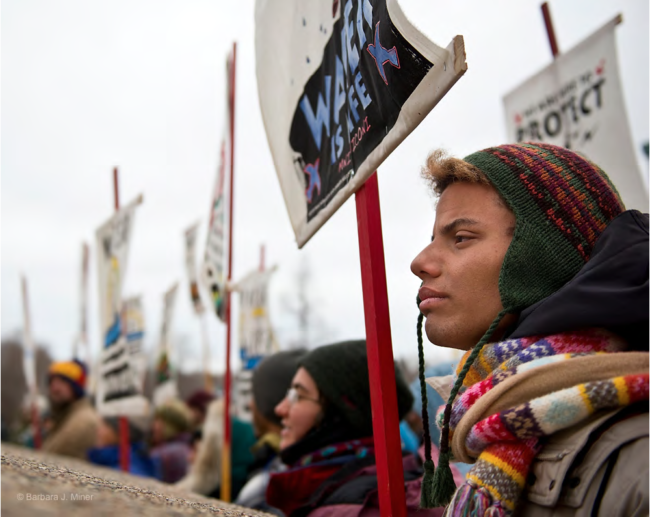
A demonstration in Bismarck, North Dakota, on Nov. 21, 2016, to protest police violence against Standing Rock Water Protectors. Source: Barbara Miner.
The more I read and learned about the Standing Rock resistance to the Dakota Access Pipeline, the more obvious it became that this story must make its way into my curriculum. Here was a fascinating and important story — a story that literally cannot be told without recognizing Native peoples as full participants in their own, and U.S., history.
I put out a call to other teachers, educators, and activists who might be interested in collaborating on some curriculum. I wanted to roll out the lessons in the days before or after Thanksgiving. This timing, I believed, would be a powerful symbolic rejection of the lies about Indian people promulgated in our national Thanksgiving myths, in favor of a real story, about real Indians, leading a powerful movement in the 21st century. Joined in the work by my fellow Lake Oswego High School teacher, Andrew Duden, and Rethinking Schools curriculum editor Bill Bigelow, we quickly agreed that the story lent itself well to a role play and got to work.
 Before launching the role play, we wanted to give students a visceral and visual sense of the resistance under way along the Missouri River. We thought immediately of Amy Goodman’s wonderful coverage on Democracy Now!, and specifically, of the horrifying footage of the use of dogs against protestors/Water Protectors by a private security firm (Democracy Now!, 2016). We also used “The Standing Rock Protests by the Numbers,” a short documentary posted at the Los Angeles Times (Etehad and Tchekmedyian, 2016). We asked students to jot down questions that emerged as they watched. Afterward, students shared out their questions and it didn’t take long for them to recognize and frame many of the fundamental issues at stake. Gavin asked, “Are the protestors more angry about the possibility of oil spills or that they’re building on burial grounds?” Kisa asked, “What guarantee does the pipeline company have against the breaking or leaking of the pipe?” Tatum wrote, “Is this pipeline really needed? What is it for? Can they move it somewhere else?” Vivian asked, “Who owns the land the pipeline is being built through?” Finally, Callie wondered, “Does the government care about what could happen to the water of these tribes?” These questions not only built toward the role play to come, but also generated possible research questions for the entire unit.
Before launching the role play, we wanted to give students a visceral and visual sense of the resistance under way along the Missouri River. We thought immediately of Amy Goodman’s wonderful coverage on Democracy Now!, and specifically, of the horrifying footage of the use of dogs against protestors/Water Protectors by a private security firm (Democracy Now!, 2016). We also used “The Standing Rock Protests by the Numbers,” a short documentary posted at the Los Angeles Times (Etehad and Tchekmedyian, 2016). We asked students to jot down questions that emerged as they watched. Afterward, students shared out their questions and it didn’t take long for them to recognize and frame many of the fundamental issues at stake. Gavin asked, “Are the protestors more angry about the possibility of oil spills or that they’re building on burial grounds?” Kisa asked, “What guarantee does the pipeline company have against the breaking or leaking of the pipe?” Tatum wrote, “Is this pipeline really needed? What is it for? Can they move it somewhere else?” Vivian asked, “Who owns the land the pipeline is being built through?” Finally, Callie wondered, “Does the government care about what could happen to the water of these tribes?” These questions not only built toward the role play to come, but also generated possible research questions for the entire unit.
The Role Play
We liked the idea of a role play for a couple reasons. Our first and most important goal was to create a context for students to confront the complex social reality of the Dakota Access Pipeline and the resistance movement to which it has given rise. That social reality includes the history and contemporary status of Indigenous rights, the power of the fossil fuel industry, the support for pipeline infrastructure from segments of organized labor, and the extent to which our government is protecting — or failing to protect — the land, water, and air. The role play asks students to explore these complicated dynamics as active participants. Reading about historical figures is like standing on the sidewalk looking at a house: You can recognize its basic shape, color, and perhaps how many levels it has. Actually assuming the identity of these historical figures allows you to step through the front door and explore what’s inside: How many rooms does it have? What’s the function of each? How are they connected? Which is the most spacious and light? Which the darkest and most cramped? Is it well-built or flimsy? We hoped this role play would enable students to navigate the #noDAPL movement from inside the house, rather than as a bystander peering in from outside. Another of our considerations was that at the moment we were writing, there was little mainstream media attention directed toward Standing Rock, so in some way, the role play was aspirational — a way of insisting that this is a Big Deal, even if that is not reflected in the media. Our aim was for students to know what was happening, but also, perhaps what was not happening, and to begin to wonder about why.
The setting of the role play is a meeting, called by the president, to hear input on whether the Dakota Access Pipeline should be completed. Students, representing five different groups, must convince him that the project should be abandoned or allowed to proceed. Two of the groups are in direct conflict:
- Members of the Standing Rock Sioux Tribe, protesting the pipeline and encamped along the Missouri River in North Dakota
- Energy Transfer Partners, the oil company building the pipeline
The other three groups we selected provide additional context on the question of whether the pipeline should be built:
- Iowa farmers who have brought lawsuits and protested another section of the same pipeline
- Our Children’s Trust, youth activists suing the federal government over its insufficient responses to and action on climate change
- North America’s Building Trades Unions, which represent the workers who consider themselves direct beneficiaries from the pipeline’s construction
After sorting students into five table groups, we distributed the role sheets, which outline each group’s beliefs and interests. We asked students to read and underline important information in their roles. Next we had students answer three questions:
- Do you support the building of the Dakota Access Pipeline? Why or why not?
- What are the three most compelling arguments or pieces of information that you want the president to consider when making his decision to proceed with or halt the construction of the pipeline?
- How do you think the president should respond to the Standing Rock Sioux protesters (and other protesters) currently blocking the way of the pipeline’s construction?
 This lesson was published in the Spring 2017 issue of Rethinking Schools.
This lesson was published in the Spring 2017 issue of Rethinking Schools.Classroom Stories

I recommend Standing with Standing Rock: A Role Play on the Dakota Access Pipeline, whether it be for teaching current issues Native communities face and/or building empathy and the importance of considering multiple perspectives.
While I don’t love many role playing lessons I’ve witnessed, I found this one to be effective and created with thoughtfulness. As a Native educator, I found that not only did this lesson seem valuable for a group of students, but I actually took away a lot for myself. As someone who views pipelines as very real threats to my communities and wholeheartedly supports pipeline opposition efforts, it was powerful for me to try on the perspective of a pipeline worker for this activity. I still strongly oppose pipelines, but this lesson forced me to humanize another side of this complex issue, to see the workers as people with not vastly different needs than mine and my family’s.
I will say that if you have Native students in your class, please be mindful of how this experience could be triggering for them, particularly with one of the media sources used in the beginning of the lesson of DAPL workers setting dogs on the water protectors. I found this to be emotional and hard to watch in the presence of others.
Maplewood, New Jersey Middle School Teacher
Video Clip:
FULL Exclusive Report: Dakota Access Pipeline Co. Attacks Native Americans with Dogs & Pepper Spray | Democracy Now!
Related Video
“Stand With Standing Rock” by David Rovics



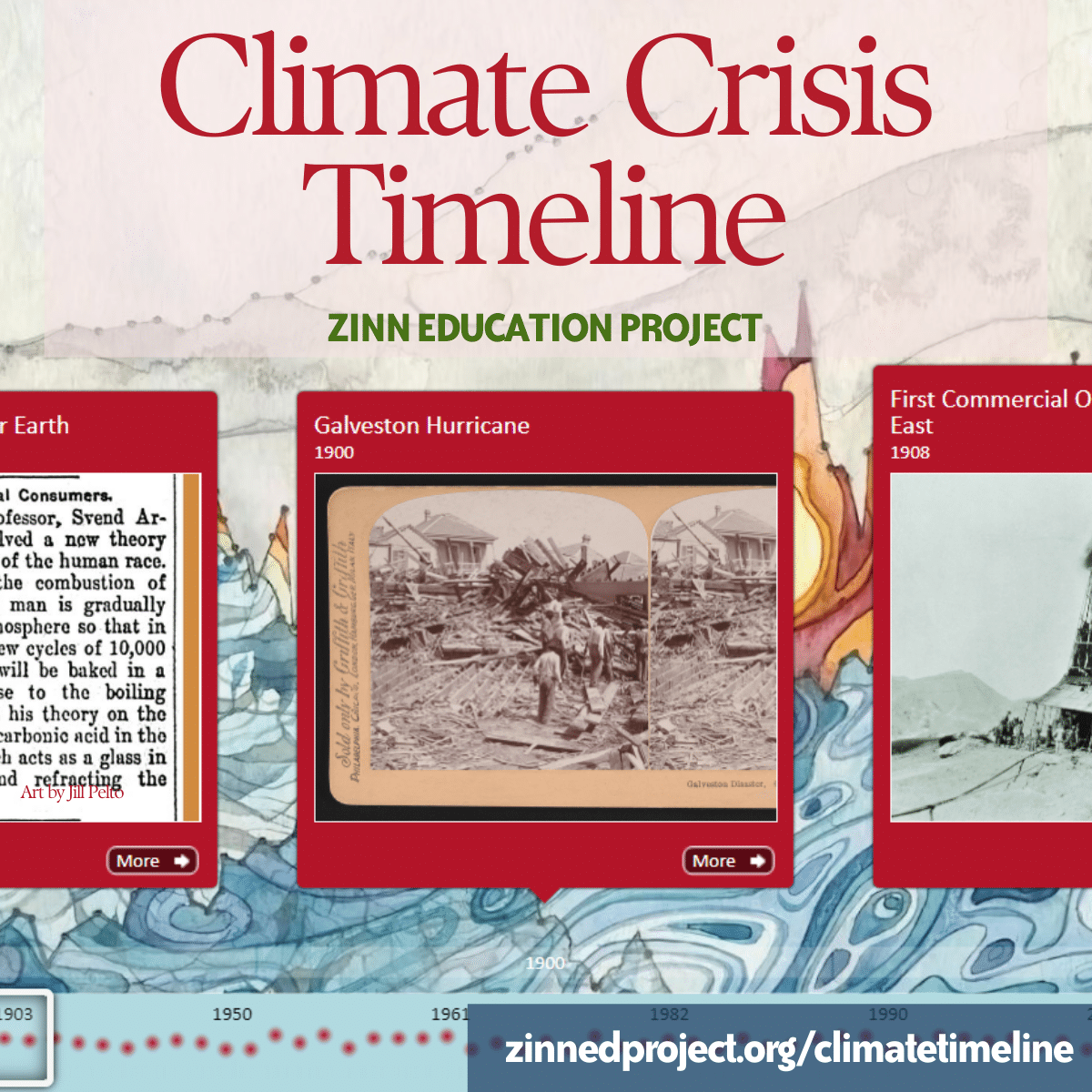
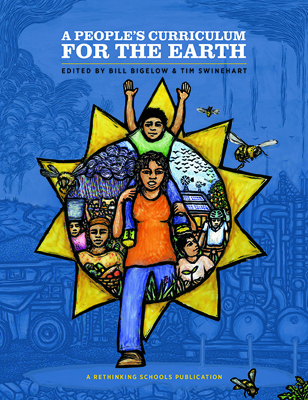
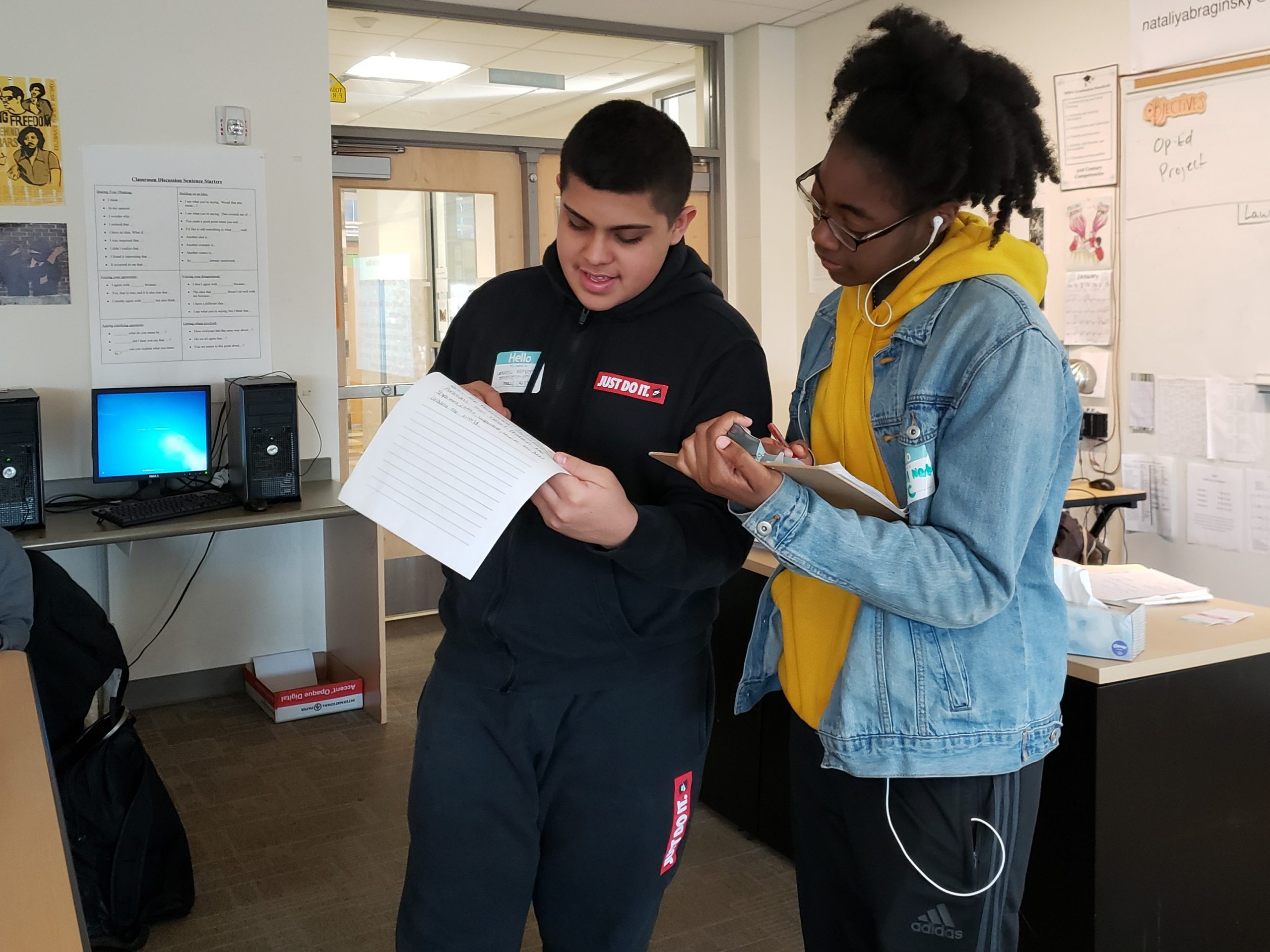
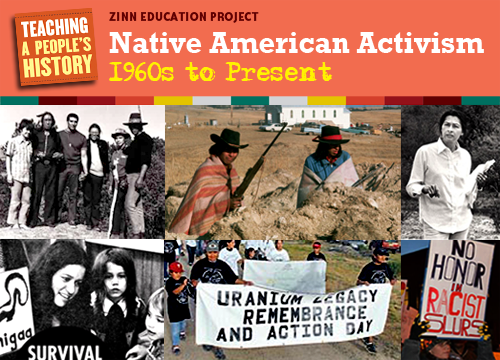






Excellent. Need more teachers to teach our children how relevant education is and how applies to their life. This is great!